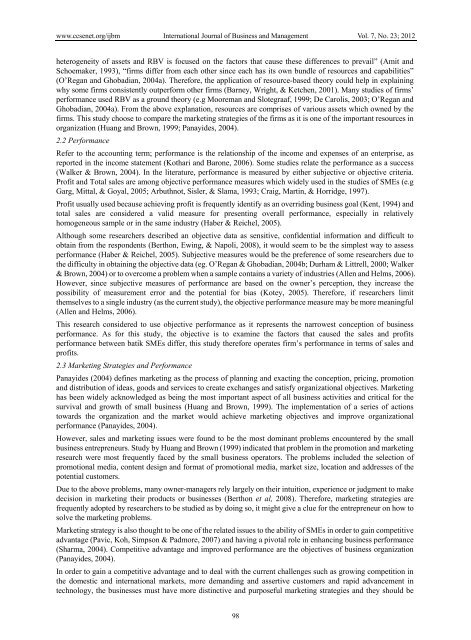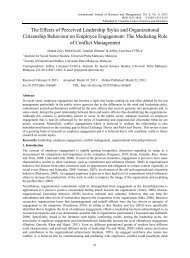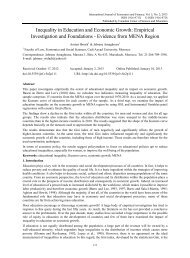Marketing%20Strategies%20and%20the%20Difference%20Level%20of%20Sales%20and%20Profits
Marketing%20Strategies%20and%20the%20Difference%20Level%20of%20Sales%20and%20Profits
Marketing%20Strategies%20and%20the%20Difference%20Level%20of%20Sales%20and%20Profits
You also want an ePaper? Increase the reach of your titles
YUMPU automatically turns print PDFs into web optimized ePapers that Google loves.
www.ccsenet.org/ijbm International Journal of Business and Management Vol. 7, No. 23; 2012<br />
heterogeneity of assets and RBV is focused on the factors that cause these differences to prevail” (Amit and<br />
Schoemaker, 1993), “firms differ from each other since each has its own bundle of resources and capabilities”<br />
(O’Regan and Ghobadian, 2004a). Therefore, the application of resource-based theory could help in explaining<br />
why some firms consistently outperform other firms (Barney, Wright, & Ketchen, 2001). Many studies of firms’<br />
performance used RBV as a ground theory (e.g Mooreman and Slotegraaf, 1999; De Carolis, 2003; O’Regan and<br />
Ghobadian, 2004a). From the above explanation, resources are comprises of various assets which owned by the<br />
firms. This study choose to compare the marketing strategies of the firms as it is one of the important resources in<br />
organization (Huang and Brown, 1999; Panayides, 2004).<br />
2.2 Performance<br />
Refer to the accounting term; performance is the relationship of the income and expenses of an enterprise, as<br />
reported in the income statement (Kothari and Barone, 2006). Some studies relate the performance as a success<br />
(Walker & Brown, 2004). In the literature, performance is measured by either subjective or objective criteria.<br />
Profit and Total sales are among objective performance measures which widely used in the studies of SMEs (e.g<br />
Garg, Mittal, & Goyal, 2005; Arbuthnot, Sisler, & Slama, 1993; Craig, Martin, & Horridge, 1997).<br />
Profit usually used because achieving profit is frequently identify as an overriding business goal (Kent, 1994) and<br />
total sales are considered a valid measure for presenting overall performance, especially in relatively<br />
homogeneous sample or in the same industry (Haber & Reichel, 2005).<br />
Although some researchers described an objective data as sensitive, confidential information and difficult to<br />
obtain from the respondents (Berthon, Ewing, & Napoli, 2008), it would seem to be the simplest way to assess<br />
performance (Haber & Reichel, 2005). Subjective measures would be the preference of some researchers due to<br />
the difficulty in obtaining the objective data (eg. O’Regan & Ghobadian, 2004b; Durham & Littrell, 2000; Walker<br />
& Brown, 2004) or to overcome a problem when a sample contains a variety of industries (Allen and Helms, 2006).<br />
However, since subjective measures of performance are based on the owner’s perception, they increase the<br />
possibility of measurement error and the potential for bias (Kotey, 2005). Therefore, if researchers limit<br />
themselves to a single industry (as the current study), the objective performance measure may be more meaningful<br />
(Allen and Helms, 2006).<br />
This research considered to use objective performance as it represents the narrowest conception of business<br />
performance. As for this study, the objective is to examine the factors that caused the sales and profits<br />
performance between batik SMEs differ, this study therefore operates firm’s performance in terms of sales and<br />
profits.<br />
2.3 Marketing Strategies and Performance<br />
Panayides (2004) defines marketing as the process of planning and exacting the conception, pricing, promotion<br />
and distribution of ideas, goods and services to create exchanges and satisfy organizational objectives. Marketing<br />
has been widely acknowledged as being the most important aspect of all business activities and critical for the<br />
survival and growth of small business (Huang and Brown, 1999). The implementation of a series of actions<br />
towards the organization and the market would achieve marketing objectives and improve organizational<br />
performance (Panayides, 2004).<br />
However, sales and marketing issues were found to be the most dominant problems encountered by the small<br />
business entrepreneurs. Study by Huang and Brown (1999) indicated that problem in the promotion and marketing<br />
research were most frequently faced by the small business operators. The problems included the selection of<br />
promotional media, content design and format of promotional media, market size, location and addresses of the<br />
potential customers.<br />
Due to the above problems, many owner-managers rely largely on their intuition, experience or judgment to make<br />
decision in marketing their products or businesses (Berthon et al, 2008). Therefore, marketing strategies are<br />
frequently adopted by researchers to be studied as by doing so, it might give a clue for the entrepreneur on how to<br />
solve the marketing problems.<br />
Marketing strategy is also thought to be one of the related issues to the ability of SMEs in order to gain competitive<br />
advantage (Pavic, Koh, Simpson & Padmore, 2007) and having a pivotal role in enhancing business performance<br />
(Sharma, 2004). Competitive advantage and improved performance are the objectives of business organization<br />
(Panayides, 2004).<br />
In order to gain a competitive advantage and to deal with the current challenges such as growing competition in<br />
the domestic and international markets, more demanding and assertive customers and rapid advancement in<br />
technology, the businesses must have more distinctive and purposeful marketing strategies and they should be<br />
98









